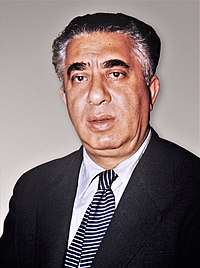Aram Khachaturian
Aram Il'yich Khachaturian (/ˈærəm ˌkɑːtʃəˈtʊəriən/;[1] Russian: Арам Ильич Хачатурян, IPA: [ɐˈram ɪˈlʲjit͡ɕ xət͡ɕɪtʊˈrʲan]; Armenian: Արամ Խաչատրյան, Aram Xačatryan;[upper-alpha 1] pronounced [ɑˈɾɑm χɑt͡ʃʰɑt(ə)ɾˈjɑn]; 6 June [O.S. 24 May] 1903 – 1 May 1978) was a Soviet Armenian composer and conductor. He is considered one of the leading Soviet composers.[5][6][7]
Aram Ilyich Khachaturian | |
|---|---|
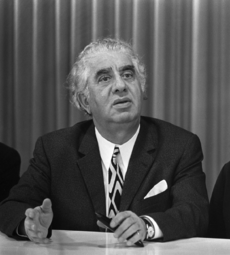 Khachaturian in 1971 | |
| Born | 6 June [O.S. 24 May] 1903 |
| Died | 1 May 1978 (aged 74) |
| Burial place | Komitas Pantheon, Yerevan, Armenia |
| Nationality | Armenian |
| Alma mater | Gnessin Musical Institute, Moscow Conservatory |
| Years active | 1926–1978 |
| Era | 20th-century classical music |
| Political party | Communist Party of the Soviet Union (from 1943) |
| Spouse(s) | Nina Makarova (1933–1976; her death) |
| Children | 2 |
| Awards | Full list |
| Signature | |
Born and raised in Tbilisi, the multicultural capital of Georgia, Khachaturian moved to Moscow in 1921 following the Sovietization of the Caucasus. Without prior music training, he enrolled in the Gnessin Musical Institute, subsequently studying at the Moscow Conservatory in the class of Nikolai Myaskovsky, among others. His first major work, the Piano Concerto (1936), popularized his name within and outside the Soviet Union. It was followed by the Violin Concerto (1940) and the Cello Concerto (1946). His other significant compositions include the Masquerade Suite (1941), the Anthem of the Armenian SSR (1944), three symphonies (1935, 1943, 1947), and around 25 film scores. Khachaturian is best known for his ballet music—Gayane (1942) and Spartacus (1954). His most popular piece, the "Sabre Dance" from Gayane, has been used extensively in popular culture and has been covered by a number of musicians worldwide.[8] His style is "characterized by colorful harmonies, captivating rhythms, virtuosity, improvisations, and sensuous melodies".[9]
During most of his career, Khachaturian was approved by the Soviet government and held several high posts in the Union of Soviet Composers from the late 1930s, although he joined the Communist Party only in 1943. Along with Sergei Prokofiev and Dmitri Shostakovich, he was officially denounced as a "formalist" and his music dubbed "anti-people" in 1948 but was restored later that year. After 1950 he taught at the Gnessin Institute and the Moscow Conservatory and turned to conducting. He traveled to Europe, Latin America and the United States with concerts of his own works. In 1957 Khachaturian became the Secretary of the Union of Soviet Composers, a position he held until his death.
Khachaturian composed the first Armenian ballet music, symphony, concerto, and film score.[upper-alpha 2] He is considered the most renowned Armenian composer of the 20th century. While following the established musical traditions of Russia, he broadly used Armenian and, to lesser extent, Caucasian, Eastern and Central European, and Middle Eastern peoples' folk music in his works. He is highly regarded in Armenia, where he is considered a "national treasure".[12]
Biography
Background and early life (1903–21)
Aram Khachaturian was born on 6 June (24 May in Old Style)[13] 1903 in the city of Tiflis (present-day Tbilisi, Georgia) into an Armenian family.[14][15] Some sources indicate Kojori, a village near Tiflis (now in Georgia's Gardabani Municipality), as his birthplace.[16][17][18] His father, Yeghia (Ilya), was born in the village of Upper Aza near Ordubad in Nakhichevan (present-day Nakhchivan Autonomous Republic, Azerbaijan) and moved to Tiflis at the age of 13; he owned a bookbinding shop by the age of 25. His mother, Kumash Sarkisovna, was from Lower Aza, also a village near Ordubad. Khachaturian's parents were betrothed before knowing each other, when Kumash was 9 and Yeghia was 19. They had 5 children, one daughter and four sons, of whom Aram was the youngest.[19] Khachaturian received primary education at the commercial school of Tiflis, a school for merchants.[20] He considered a career either in medicine or engineering.[21]
In the 19th and early 20th centuries and throughout the early Soviet period, Tiflis (known as Tbilisi after 1936) was the largest city and the administrative center of the Caucasus. In Tiflis, which has historically been multicultural, Khachaturian was exposed to various cultures.[22] The city had a large Armenian population and was a major Armenian cultural center until the Russian Revolution and the following years. In a 1952 article "My Idea of the Folk Element in Music", Khachaturian described the city environment and its influence on his career:
I grew up in an atmosphere rich in folk music: popular festivities, rites, joyous and sad events in the life of the people always accompanied by music, the vivid tunes of Armenian, Azerbaijani and Georgian songs and dances performed by folk bards [ashugs] and musicians — such were the impressions that became deeply engraved on my memory, that determined my musical thinking. They shaped my musical consciousness and lay at the foundations of my artistic personality... Whatever the changes and improvements that took place in my musical taste in later years, their original substance, formed in early childhood in close communion with the people, has always remained the natural soil nourishing all my work.[23]
In 1917, the Bolsheviks rose to power in Russia in the October Revolution. After over two years of fragile independence, Armenia fell to Soviet rule in late 1920. Georgia was also Sovietized by the spring of 1921. Both countries formally became part of the Soviet Union in December 1922.[24] Khachaturian later wrote that "the October Revolution fundamentally changed my whole life and, if I have really grown into a serious artist, then I am indebted only to the people and the Soviet Government. To this people is dedicated my entire conscious life, as is all my creative work."[25] Khachaturian always remained enthusiastic about communism,[26] and was an atheist.[27] When asked about his visit to the Vatican, Khachaturian responded: "I'm an atheist, but I'm a son of the [Armenian] people who were the first to officially adopt Christianity and thus visiting the Vatican was my duty."[28][29]
Education (1922–36)
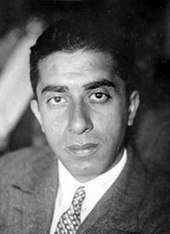
In 1921, the eighteen-year-old Khachaturian moved to Moscow to join his oldest brother, Suren, who had settled in Moscow earlier and was a stage director at the Moscow Art Theatre by the time of his arrival.[20][19] He enrolled at the Gnessin Musical Institute in 1922, simultaneously studying biology at the Moscow University.[21][30] He initially studied the cello under Sergei Bychkov and later under Andrey Borysyak.[31][15] In 1925, Mikhail Gnessin started a composition class at the institute, which Khachaturian joined.[32][20] In this period, he wrote his first works: the Dance Suite for violin and piano (1926) and the Poem in C Sharp Minor (1927).[21][30] Beginning with his earliest works, Khachaturian extensively used Armenian folk music in his compositions.
In 1929, Khachaturian entered the Moscow Conservatory to study composition under Nikolai Myaskovsky and orchestration under Sergei Vasilenko.[33] In 1933, he married the composer Nina Makarova, a fellow student from Myaskovsky's class.[34] He finished the conservatory in 1934 and went on to complete his graduate work in 1936.[20]
Early career (1936–48)
His Armenian-influenced First Symphony, which Khachaturian composed as a graduation work from the Moscow Conservatory in 1935, "drew the attention of prominent conductors and was soon performed by the best Soviet orchestras"[22] and was admired by Shostakovich.[23] He began an active creative career upon completing his graduate studies at the conservatory in 1936.[30] He wrote his first major work, the Piano Concerto, that year.[21] It proved to be a success, establishing him as a respected composer in the Soviet Union.[15] It was "played and acclaimed far beyond the borders of the Soviet Union,"[6] and "established his name abroad."[22]
His Piano Concerto, along with the two later concertos—the Violin Concerto (1940), for which he won a State Prize (called the Stalin Prize then, the highest artistic award in the Soviet Union),[21][22] and the Cello Concerto (1946)—are "often considered a kind of a grand cycle."[15] The Violin Concerto "gained international recognition"[6] and became part of the international repertory.[22] It was first performed by David Oistrakh.[22]
Khachaturian held important posts at the Composers' Union, becoming deputy chairman of the Moscow branch in 1937. He subsequently served as the Deputy Chairman of the Organizing Committee (Orgkom) of the Union between 1939 and 1948.[17][35] He joined the Communist Party in 1943.[20] "Throughout the early and mid-1940s, Khachaturian used that position to help shape Soviet music, always stressing but technically masterful composition. In fact, in his memoirs he reported pride about leading an institution that organized creative work in many musical genres and especially in all Soviet republics."[36]
The years preceding and following World War II proved to be very productive for Khachaturian. In 1939 Khachaturian made a six-month trip to his native Armenia "to make a thorough study of Armenian musical folklore and to collect folk-song and dance tunes" for his first ballet, Happiness which he completed in the same year. "His communion with Armenia's national culture and musical practice proved for him as he put it himself, 'a second conservatoire'. He learned a lot, saw and heard many things anew, and at the same time he had an insight into the tastes and artistic requirements of the Armenian people."[37] In 1942, at the height of the Second World War, he reworked it into the ballet Gayane.[38] It was first performed by the Kirov Ballet (today known as Mariinsky Ballet) in Perm, while Leningrad was under siege. It was a great success that earned Khachaturian a Soviet State Prize.[30] Khachaturian returned the money of the prize to the state with a request to use it for building a tank for the Red Army.[39]
He composed the Second Symphony (1943) on the occasion of the 25th anniversary of the October Revolution and incidental music to Masquerade (1944), "a symphonic suite in the tradition of lavish classical Russian music", on Mikhail Lermontov's play of the same title.[21] Both the ballet Gayane and the Second Symphony were "successful and were warmly praised by Shostakovich."[15] In 1944, Khachaturian composed the largely symbolic Anthem of the Armenian Soviet Socialist Republic.[10]
Denunciation and restoration (1948)
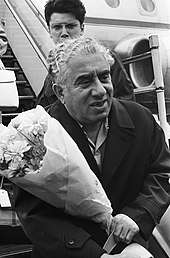
In mid-December 1947, the Department for Agitation and Propaganda (better known as Agitprop) submitted to Andrei Zhdanov, the secretary of the Communist Party's Central Committee, a document on the "shortcomings" in the development of Soviet music. On 10–13 January 1948, a conference was held at the Kremlin in the presence of seventy musicians, composers, conductors and others who were confronted by Zhdanov:[40]
We will consider that if these comrades Shostakovich, Prokofiev, Myaskovsky, Khachaturian, Kabalevsky and Shebalin namely who are the principal and leading figures of the formalist direction in music. And that direction is fundamentally incorrect.
Thus, Khachaturian and other leading composers were denounced by the Communist Party as followers of the alleged formalism[15] (i.e. "[a type of] music that was considered too advanced or difficult for the masses to enjoy")[6] and their music was dubbed "anti-people".[41] It was the Symphonic Poem (1947), later titled the Third Symphony, that officially earned Khachaturian the wrath of the Party.[40][42] Ironically, he wrote the work as a tribute to the 30th anniversary of the October Revolution.[43] He stated: "I wanted to write the kind of composition in which the public would feel my unwritten program without an announcement. I wanted this work to express the Soviet people's joy and pride in their great and mighty country."[44]
Musicologist Blair Johnston believes that his "music contained few, if any, of the objectionable traits found in the music of some of his more adventuresome colleagues. In retrospect, it was most likely Khachaturian's administrative role in the Union [of Soviet Composers], perceived by the government as a bastion of politically incorrect music, and not his music as such, which earned him a place on the black list of 1948."[45] In March 1948,[25] Khachaturian "made a very full and humble apology for his artistic "errors" following the Zhdanov decree; his musical style, however, underwent no changes."[45] He was sent to Armenia as a "punishment",[15] and continued to be censured.[25] By December 1948 he was restored to favor, receiving praise for his score for Vladimir Ilyich Lenin (ru), a film biography of the Soviet leader.[21][25]
Later life (1950–78)
In 1950, Khachaturian began conducting[45] and started teaching composition at his alma maters—the Gnessin Institute (since 1950), and later at the Moscow Conservatory (since 1951).[17] Some of his notable students include Aziz El-Shawan,[46] Andrei Eshpai,[10] Anatol Vieru,[10] Edgar Hovhannisyan,[16] Mikael Tariverdiev,[10] Mark Minkov,[47] Alexey Rybnikov,[48] Tolib Shakhidi,[49] Georgs Pelēcis,[50] Rostislav Boiko (ru),[16] and Nodar Gabunia (ru).[16] During his career as a university professor, Khachaturian emphasized the role of folk music to his students and instilled the idea that composers should master their nations' folk music heritage.[17]
In 1950, he began working on his third and last ballet, Spartacus (1950–54), which later proved to be his last internationally acclaimed work.[15] He was named People's Artist of the Soviet Union in 1954.[21] He revised Spartacus in 1968.[15]
"Following the success of Spartacus toward the end of the fifties, his remaining years were devoted less to composition, and more to conducting, teaching, bureaucracy and travel."[23] He served as the President of the Soviet Association of Friendship and Cultural Cooperation with Latin American States from 1958[13] and was a member of the Soviet Peace Committee (since 1962).[17] "He frequently appeared in world forums in the role of champion of an apologist for the Soviet idea of creative orthodoxy."[21] Khachaturian toured with concerts of his own works in around 30 countries, including in all the Eastern Bloc states,[10] Italy (1950), Britain (1955, 1977), Latin America (1957) and the United States (1960, 1968).[6][23][7] His January 1968 visit to U.S. capital of Washington, D.C. was a significant one. He conducted the National Symphony Orchestra in a program of his own works.[45]
Khachaturian went on to serve again as Secretary of the Composers Union, starting in 1957 until his death.[13][17] He was also a deputy in the fifth Supreme Soviet of the Soviet Union (1958–62).[51] In the last two decades of his life, Khachaturian wrote three concert rhapsodies—for violin (1961–62), cello (1963) and piano (1965)[43]—and solo sonatas for unaccompanied cello, violin, and viola (1970s), which are considered to be his second and third instrumental trilogies.[15]
Khachaturian died in Moscow on 1 May 1978, after a long illness,[7] just short of his 75th birthday.[43] He was buried at the Komitas Pantheon[52] in Yerevan on 6 May, next to other distinguished Armenians.[10] He was survived by his son, Karen, and daughter, Nune,[19] and his nephew, Karen Khachaturian, who was also a composer.[15]
Music
Khachaturian's works span a broad range of musical types, including ballets, symphonies, concertos, and film scores. Music critic Edward Greenfield expresses the opinion that Khachaturian "notably outshone other Soviet contemporaries in creating a sharply identifiable style, something which his successors have found impossible to emulate".[23] He composed a great portion of his works in a ten-year span between 1936 and 1946, preceding and following the Second World War.[53] Despite his formal restoration after the 1948 denunciation, Khachaturian only succeeded in composing one internationally acclaimed work in the last 30 years of his life, the ballet Spartacus.[22]
According to James Bakst, what made Khachaturian unique among Soviet composers is "the blending of national Armenian vocal and instrumental intonations with contemporary orchestral techniques".[54] Khachaturian's music is characterized by an active rhythmic development, which reaches either a mere repetition of the basic formula (ostinato) or "a game of emphasis within this formula".[55]

Works
Ballets
Khachaturian is best known internationally for his ballet music.[upper-alpha 3] His second ballet, Gayane, was largely reworked from his first ballet, Happiness.[42][57] Spartacus became his most acclaimed work in the post-Stalin period. These two compositions "remain his most successful compositions".[58] According to Jonathan McCollum and Andy Nercessian, his music for these two ballets "can safely be included among the best known pieces of classical music throughout the world, a fact that is vitalized by perception that these are perhaps the only works through that the world really knows Armenian music".[59] Ann Haskins of LA Weekly suggests that he has thus "made an indelible mark on the world of ballet".[60]
Spartacus was popularized when the "Adagio of Spartacus and Phrygia" was used as the theme for a popular BBC drama series The Onedin Line during the 1970s.[43] The climax of Spartacus was also used in films such as Caligula (1979)[61] and Ice Age: The Meltdown (2006).[62] Joel Coen's The Hudsucker Proxy (1994) also prominently featured music from Spartacus and Gayane (the "Sabre Dance" included).[62] Gayane's "Adagio" was used, among other films, in Stanley Kubrick's futuristic film 2001: A Space Odyssey.[63]
Orchestral music
Khachaturian wrote three symphonies: the First in 1934/5, the Second in 1943, and the Third in 1947.[15][64] He also wrote three concertos: the Piano Concerto (1936), the Violin Concerto (1940), and the Cello Concerto (1946).[15]
Other compositions
Khachaturian wrote incidental music for several plays, including Macbeth (1934, 1955), The Widow from Valencia (1940), Masquerade (1941), King Lear (1958).[15] He produced around 25 film scores.[43][64] Among them is Pepo (1935), the first Armenian sound film.[58] In 1950 he was awarded the USSR State Prize (Stalin Prize) for the score of The Battle of Stalingrad (1949).[10]
Influences
—Khachaturian[65]
Musicologist Marina Frolova-Walker describes Khachaturian as the only internationally renowned Soviet composer "who emerged from the nationalist project".[66] James Bakst interpreted Khachaturian's views as follows: "Music is a language created by the people. The people create intonational music forms which reveal at once his national elements of an art work."[67]
Composer Tigran Mansurian suggested that Khachaturian's music incorporates American characteristics and called the United States his "second homeland" in terms of musical influences, especially due to the sense of optimism in his works and lifestyle.[68]
Armenian folk music
Khachaturian is widely known for his use of folk songs of various ethnic groups in his compositions, most notably those of Armenians.[upper-alpha 4] Despite not having been born in Armenia, Khachaturian was "essentially an Armenian composer whose music exhibits his Armenian roots".[56] "[M]any of his compositions evoke an Armenian melodic line. However, his works markedly differed from the conventional orchestrations of folk themes," writes Rouben Paul Adalian. He suggests that Khachaturian's works carry "the vibrant rhythms and stirring pace of Caucasian dance music", but at the same time are "original compositions that reworked that cultural material through new instrumentation and according to European musical canons, resulting in a sound unique to the composer".[58] He was particularly influenced by the folk-song collector, musicologist Komitas,[69] and composers Alexander Spendiaryan and Romanos Melikian.[upper-alpha 5] Khachaturian acknowledged that Komitas "singlehandedly laid the foundations for Armenia's classical tradition".[71] In a 1969 article about Komitas, Khachaturian called him his "greatest teacher".[72]
His plans to write an opera "on the destiny of the Armenian people, the tragic fate of Armenians scattered all over the world, their suffering and the struggle" never realized, and his "Armenian Rhapsody for mouth-organ and orchestra, intended for his close friend Larry Adler and the Chicago Symphony Orchestra" remained uncompleted. "Yet the intention, the spirit, was always there."[23] Khachaturian emphasized his Armenian origin, stating:[22]
No matter how I may waver between various musical languages, I remain an Armenian, but a European Armenian, not an Asian Armenian. Together with other [Armenian composers], we will make all of Europe and the whole world listen to our music. And when they hear our music, people are certain to say, 'Tell us about that people, and show us the country that produces such art.'
Other folk music
During his university years, Khachaturian transcribed Armenian, Russian, Hungarian, Turkish and other folk songs.[13] In his mature works, Khachaturian used elements from folk songs of Caucasian (including, but not limited to Georgians), Eastern European (Ukrainians, Poles) and Middle Eastern (Turks, Kurds) peoples.[upper-alpha 6] His first ballet, Happiness, incorporates a Ukrainian gopak, Georgian, Armenian and Russian dances and a Lezginka, an energetic dance of many Caucasian peoples.[73] The Masquerade Suite includes a Mazurka, a Polish folk dance music.[74] The ballet Gayane, like its predecessor, features a Lezginka.[74] Act II of Gayane "is filled with Kurdish dances".[75]
Russian classical music
Khachaturian is cited by musicologists as a follower of Russian classical traditions.[upper-alpha 7] According to the Toronto Symphony Orchestra, he "carried forward into the twentieth century the colourful, folk-inspired style of such nineteenth-century Russian composers as Rimsky-Korsakov and Tchaikovsky".[76] Like the members of The Five, especially Alexander Borodin and Rimsky-Korsakov, whose works to some extent served him as a model, Khachaturian drew heavily upon "Eastern" and "Oriental" material in creating compositions in various classical genres and styles of European origin. But Khachaturian's cultural identity and rigorous musical training within the Soviet establishment allowed him to penetrate more deeply to the essence of Eastern and Caucasian music and to incorporate it more fully in his mature work, including the ballets.[77] "Never dissociating himself from the traditions of Russian music, he came to be regarded in Moscow as a mouthpiece of the entire Soviet Orient, gathering up all the diverse traditions into a grand generalization," concludes Marina Frolova-Walker.[66]
Legacy
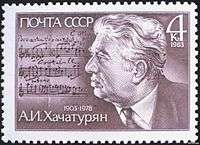
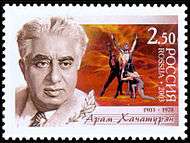

Recognition
Khachaturian is generally considered one of the leading composers of the Soviet Union.[5] Alongside Dmitri Shostakovich and Sergei Prokofiev, he has been generally cited as one of the three greatest composers of the Soviet era.[78][79] As early as 1957 Time magazine called Prokofiev, Shostakovich and Khachaturian "the three modern giants" of Soviet music.[80] They are sometimes collectively referred to as the three "titans" of Soviet music.[81][82] "Whether or not history will support the verdict, Khachaturian in his lifetime ranked as the third most celebrated Soviet composer after Shostakovich and Prokofiev," wrote the music critic Ronald Crichton in 1978.[23] According to the Los Angeles Philharmonic, "his works do not enjoy the international reputation that those of" Shostakovich and Prokofiev do.[57] With the two aforementioned composers and Dmitry Kabalevsky, Khachaturian "was one of the few Soviet composers to have become known to the wider international public".[83] According to music historian Harlow Robinson, "his proletariat origins, non-Russian ethnic origins and Soviet training [made him] a powerful symbol within the Soviet musical establishment of the ideal of a multinational Soviet cultural identity, an identity which the composer enthusiastically embraced and exploited both at home and abroad". Unlike Prokofiev and Shostakovich, Khachaturian was "entirely a creation of the Soviet musical and dance establishment".[84]
Reputation in the West
Josef Woodard, writing for the Los Angeles Times, suggests that he has "long [been] considered a lighter-weight participant among 20th-century composers,"[85] while classic music broadcaster Norman Gilliland describes him as a "major" composer of the 20th century.[86] Although describing him as an important and highly popular composer and a "man of pronounced gifts", Harold C. Schonberg argued in 1978 that Khachaturian "frankly composed popular music" and that after being exposed to his work it becomes evident that it is mostly "formula writing." While praising his work as exotic and colorful, he described Khachaturian as a "bureaucratic composer, turning out well-crafted pieces of no particular personality, and certainly nothing that would rock the boat."[87]
Tim Ashley wrote in The Guardian in 2009 that Khachaturian's popularity fell in the West, because of his image as one of Soviet music's "yes-men". He argued, "Such a view is simplistic, given that he had a major brush with the authorities in 1948. But it's also easy to see how he acquired his awkward reputation when you hear his Violin Concerto, dating from 1940. It's an immensely attractive work, full of his trademark Armenian folk flourishes, and the swaying, hypnotic Andante is notably beautiful. But the unforced optimism of the outer movements now seems unthinking when we realise it was composed at a time when Stalin was giving Prokofiev and Shostakovich hell."[88] In 2003 conductor Marin Alsop opined that Khachaturian is "very underperformed" and "somewhat underrated". She commented further: "His music, of course, has a little bit of the edginess of the 20th-century sound, the dissonances coming in. But at the same time it marries this beautiful neo-romanticism and lush orchestration and the over-the-top approach, so I think, he can be quite relevant these days."[8]
In Armenia

Khachaturian was the most renowned Armenian composer of the 20th century,[89] and the most famous representative of Soviet Armenian culture.[90] He has been described as "by far the most important Armenian composer",[91] the "Armenian Tchaikovsky",[92] and deemed a key figure in 20th-century Armenian culture.[93] He remains the only Armenian composer to rise to international significance.[upper-alpha 8] Khachaturian is highly regarded in Armenia[94] and considered a national treasure.[12] Khachaturian is embraced and celebrated by the Armenian people "as a famous son who earned world-wide recognition".[95] Şahan Arzruni has described Khachaturian as "the musical ambassador of Armenian culture".[96] David Marshall Lang noted in his 1970 book on Armenia that "For making Armenia's popular musical heritage known all over the world, his homeland pays him well deserved acclaim."[97]
He had a great influence on the development of Armenian music in the 20th century. "Naturally, he immediately became an example for young national composers and a hero in Armenia," suggests Maya Pritsker.[22] Khachaturian's influence can be traced in nearly all trends of Armenian classical music traditions (symphonic and chamber), including on Arno Babajanian, a significant Armenian composer of the late Soviet period.[98] His unique symphonic interpretation has influenced Edvard Mirzoyan, Konstantin Orbelyan and others.[99] Khachaturian is credited for bringing Armenian music worldwide recognition.[13] Poet Hamo Sahyan said about Khachaturian: "He became the big denial of our myth of smallness, [he] became the symbol of measuring our small people with the great ones... [He] became our certificate of civilization."[100]
Posthumous honors and tribute
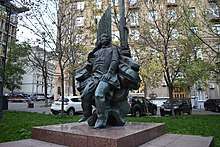
The philharmonic hall of the Yerevan Opera Theater has been officially called the Aram Khachaturian Grand Concert Hall since 1978.[10] The House-Museum of Aram Khachaturian in Yerevan was inaugurated in 1982.[101]
Music schools are named after Khachaturian in Tbilisi,[102] Moscow (established in 1967, named after him in 1996),[103] Yerevan,[51] Martuni in Nagorno-Karabakh,[104] and Watertown, Massachusetts, US (run by the Hamazkayin Armenian Educational and Cultural Society).[105] Streets in Yerevan,[106] Tbilisi,[107] Moscow (ru), Nur-Sultan (Kazakhstan)[108] and Simferopol (Crimea)[109] are named after Khachaturian.
On 31 July 1999 a three-and-a-half meter high statue of Khachaturian in 19th-century realist style[110] by Yuri Petrosyan was unveiled before the Khachaturian Hall of the Yerevan Opera Theater in attendance of President Robert Kocharyan, Speaker Karen Demirchyan and leading poet Silva Kaputikyan.[111] A statue of Khachaturian by Georgiy Frangulyan was unveiled in Moscow on 31 October 2006. Notable attendees included Armenian President Kocharyan, Moscow Mayor Yury Luzhkov and Russia's First Lady Lyudmila Putina.[112] On 30 April 2013, a bust of Khachaturian erected by sculptor Gevorg Gevorgyan was opened in the street named after him in Yerevan's Arabkir district by Yerevan Mayor Taron Margaryan on his 110th anniversary.[113]
In 1998, the Central Bank of Armenia issued 50-dram banknotes depicting Khachaturian's portrait and the Yerevan Opera Theater on the obverse and an episode from the ballet Gayane and Mount Ararat on the reverse. It remained in use until 2004 when it was replaced by a coin.[114] He is one of the two composers depicted on the Armenian currency (the other is Komitas, who is depicted on the 10,000 dram banknote since 2018).
In 1983, the Yerevan Studio produced a TV documentary film on Khachaturian.[115] In 2003, an 83-minute-long documentary about Khachaturian with unique footage was directed by Peter Rosen and narrated by Eric Bogosian.[116] The film won the Best Documentary at the 2003 Hollywood Film Festival.[117] In 2004, TV Kultura, Russia's government-owned art channel, made a documentary on Khachaturian entitled Century of Aram Khachaturian (Век Арама Хачатуряна).[118]
In 1993 the festival of symphonic music Aram Khachaturian-93 was held in Yerevan.[51] The Aram Khachaturian International Competition (Արամ Խաչատրյանի անվան միջազգային մրցույթ) is held annually in Yerevan since 2003.[119]
In 2009, Russia's flag carrier, Aeroflot, named one of its Airbus A319-112 planes after Khachaturian.[120]
In 2013,[121] UNESCO inscribed a collection of Khachaturian's handwritten notes and film music in the Memory of the World Register.[122]
Awards and honors
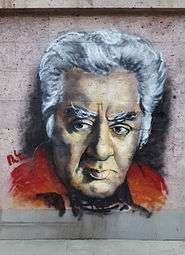
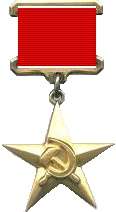


- Honored Art Worker of the Armenian SSR (1938), Russian SFSR (1944), Uzbek SSR (1967)


- Lenin Prize (1959) for the ballet Spartacus
- USSR State Prize (1941 for Violin Concerto, 1943 for ballet Gayane, 1946 for the Second Symphony, 1950 for the film The Battle of Stalingrad, 1971 for the Triad of Concerto-Rhapsodies: for violin and orchestra; for cello and orchestra; for piano and orchestra)
Other states[124]
- Order of the Science of Art of the United Arab Republic (1961, "for outstanding musical achievements")
- Medal of Pope John XXIII (1963)
- Medal of the Iranian Shah (1965)
- Honored Art Worker of People's Republic of Poland (1972, "for contribution to the Polish culture")

Academic titles[17]
- Professor of Music — 1950
- Honorary Member of the Accademia Nazionale di Santa Cecilia, Rome, Italy — 1960
- Corresponding Member of the Academy of Arts of the German Democratic Republic — 1961
- Honorary Professor of the Conservatorio Nacional de Música, Mexico — 1960
- Full Member (Academician) of the Academy of Sciences of the Armenian SSR — 1963
- Doctor of Arts (Доктор искусствоведения), Academy of Sciences of the USSR — 1965[13]
References
Notes
- Xačatryan is the standard transliteration of his last name.[2] It is sometimes spelled Khachatryan by official Armenian sources.[3][4]
- "Նա ազգային առաջին բալետի, սիմֆոնիայի, գործիքային կոնցերտների հեղինակն է, հայկ. կինոերաժշտության հիմնադիրը:" He is the author of the first national ballet, symphony, concerto, first Arm. film score.[10]
"В 1939 году Арам Хачатурян сочинил музыку к первому армянскому балету «Счастье»." In 1939 Aram Khachaturian wrote the music to the first Armenian ballet Happiness.[11] - "Khachaturian's world renown ... was due to his two Romantic ballets Gayaneh and Spartacus, and his attractively melodious concertos."[34]
"Khachaturian is principally known for his ballet music..."[56]
"...it is for his ballet music that he was and remains best known both in the Soviet Union and in the West."[20]
"...his fame in the West rests chiefly on two ballets, Gayane (1942) and Spartacus (1954)...[43] - "Khachaturian's characteristic musical style draws on the melodic and rhythmic vitality of Armenian folk music."[45]
"...Armenian folk [music] ... can be heard in nearly all Khachaturian's works."[34]
"In these Khachaturian displays a characteristic vitality of rhythm, a penchant for rich orchestration and an effulgent melodic style, frequently owing much to the inflections of the folk music of his native Armenia."[43]
"The exotic lyrical patterns and improvisatory characteristics of Khachaturyan's music are the result of national Armenian intonations."[54]
"The influence of Armenian folk music can be seen in the frequent hectic ostinatos, in chords based on fourths and fifths (inspired by the open strings of the Armenian saz), and a rhapsodic improvisational form of melody."[34] - "Նրա արվեստը սերտորեն առնչվում է Կոմիտասի, Ա. Սպենիարյանի, Ռ. Մելիքյանի ստեղծագործություններին, հատկապես հայ ժող. երաժշտությանը:"[70]
"... he repeatedly acknowledged his Armenian predecessors (Komitas, for instance), he evolved his musical language from ethnic models, and he took as his creed the words of the Armenian pioneer Spendarian, who advised him to "study the music of your own people and drink in the sound of life".[23] - "...music which not only makes use of the folklore of Armenia, but also draws upon the national characteristics of Georgia, the Ukraine, Turkey, etc."[56]
- "At the same time, Khachaturyan is closely associated with Russian music as an outstanding school of artistic craftsmanship, and with its humane lyricism."[54]
"Khachaturian's own musical style reflected his background. He was highly skilled and well trained in the Russian classical tradition, and he frequently utilize the rich folk music traditions of the Caucasus in his original compositions, especially the ballet."[20]
"Khachaturian became a manifestation of one of the cornerstones of Soviet arts policy – the combination of the folk heritage of the various Socialist Republics with Russia's artistic traditions, embodied in music by composers such as Tchaikovsky and Rimsky-Korsakov."[57] - "Aram Khachaturian was the first, and so far the only, Armenian composer to achieve world renown."[34]
Citations
- "Khachaturian". Collins English Dictionary Complete & Unabridged 10th ed. 2009.
- "Khatchatourian, Aram (1903–1978)". Bibliothèque nationale de France.
Xačatryan, Aram (1903–1978) forme internationale translit.-ISO arménien
. - "Aram Khachatryan 110-Anniversary Celebrations Committee Holds Meeting". Government of the Republic of Armenia. 27 March 2013.
- "110th anniversary of Aram Khachatryan celebrated in Yerevan" (6 June 2013). Armenpress.
- Huang, Hao, ed. (1999). Music in the 20th century: Volume 2. M. E. Sharpe. p. 341. ISBN 9780765680129.
Aram Khachaturian was a leading Soviet composer...
- Encyclopedia of Music in the 20th Century 2013
- New York Times obituary 1978.
- Huizenga, NPR 2003
- Bakst 1977, p. 339.
- Geodakyan 1979, p. 19.
- "Гаянэ" [Gayane] (in Russian). Mariinsky Theatre. 22 July 2014. Archived from the original on 17 August 2014.
- Frolova-Walker 1998, p. 371.
- Geodakyan 1979, p. 18.
- Promeet, Dutta (18 November 2013). "Aram Khachaturian". Encyclopædia Britannica. Archived from the original on 13 March 2014.
- Harvard Biographical Dictionary of Music 1996, p. 445
- Geodakyan 1981
- "Хачатурян Арам Ильич [Khachaturian Aram Ilyich]" (in Russian). Moscow Conservatory. Archived from the original on 15 August 2014.
- Cramer, Alfred W., ed. (2009). Musicians and Composers of the 20th Century-Volume 3. Salem Press. p. 766. ISBN 9781587655159.
The Life Aram Ilich Khachaturian was born on June 6, 1903, in Kodjori, a suburb of Tbilisi.
- "Family tree". Virtual Museum of Aram Khachaturian. Archived from the original on 12 March 2014.
- Tomoff 2006, p. 34.
- Encyclopedia of World Biography 2004
- Pritsker 2003
- Orga 1997
- Minahan, James (2004). The Former Soviet Union's Diverse Peoples: A Reference Sourcebook. Santa Barbara, California: ABC-CLIO. p. 160. ISBN 9781576078235.
- Current Biography Yearbook 1949
- Steyn 2009, p. 13.
- Hamalian, Leo (1980). As others see us: the Armenian image in literature. New York: Ararat Press. p. 46. ISBN 978-0933706170.
Aram Khachaturian ... Besides his being an atheist, his Armenian descent...
- Volkov, Solomon. Они сократили целых 4 такта моей музыки!. Novoye Vremya (in Russian). Yerevan. Archived from the original on 22 August 2014.
По поводу поездки в Рим композитор отметил: "Я — атеист, но являюсь сыном народа, первым в истории официально принявшим христианство, и потому посещение Ватикана было моим долгом".
- Arakelov, Sergey (April 2006). "Воспоминания о маэстро". Noev Kovcheg Magazine (in Russian). Archived from the original on 27 December 2014.
- "Биография Арама Хачатуряна [Aram Khachaturian's biography]" (in Russian). RIA Novosti. 6 June 2013. Archived from the original on 13 March 2014.
- Shneerson 1959, p. 24.
- Shneerson 1959, p. 25.
- Shneerson 1959, p. 29.
- Complete Classical Music Guide 2012, p. 301
- Schwarz, Boris (1980). "Khachaturian, Aram". The New Grove Dictionary of Music and Musicians. London: Oxford University Press.
- Tomoff 2006, pp. 34–35.
- Steyn 2009, p. 11.
- Yuzefovich 1985, p. 127.
- Slonimsky, Nicolas (1944). "Soviet Music and Musicians". The Slavonic and East European Review. 3 (4): 15. JSTOR 3020186.
- Fay, Laurel E. (2005). Shostakovich: A Life. New York: Oxford University Press. pp. 155–157, 160. ISBN 9780195182514.
- Mazullo, Mark (2010). Shostakovich's Preludes and Fugues: Contexts, Style, Performance. New Haven, Connecticut: Yale University Press. p. 14. ISBN 9780300149432.
- Greene's Biographical Encyclopedia of Composers 1985
- The Musical Times 1978
- Yuzefovich 1985, p. 191.
- Johnston, AllMusic 2005
- "Aziz El-Shawan". OVGuide. Archived from the original on 2014-07-14. Retrieved 2014-02-01.
- Музыку Люблю Даже Больше, Чем Себя. Novaya Gazeta (in Russian). 17 March 2003.
- Vasyanin, Andrey (16 July 2010). Авось, все будет хорошо. Rossiyskaya Gazeta (in Russian).
- Европейскую классическую музыку лучше всех теперь пишут сыны Востока. pravda.ru (in Russian). 10 May 2006.
- "Арам Ильич Хачатурян и его ученики [Aram Ilyich Khachaturian and his students]" (in Russian). Moscow Conservatory. 16 June 2013.
- "Khachaturian Aram". Yerevan State University Institute for Armenian Studies. Archived from the original on 13 March 2014.
- Khachaturian's memorial tombstone at Komitas Pantheon
- Lebrecht 1996, p. 431.
- Bakst 1977, p. 336.
- "Хачатурян, Арам Ильич [Khachaturian, Aram Ilyich]" (in Russian). Krugosvet. Archived from the original on August 21, 2014.
Характернейшим качеством музыки Хачатуряна является активное ритмическое развитие, достигающееся часто простым повторением основной формулы (остинато) или игрой акцентов внутри этой формулы.
- Rosenberg 1987, p. 112.
- "Sabre Dance from "Gayane"". Los Angeles Philharmonic Association. Archived from the original on 2014-04-13. Retrieved 2013-12-10.
- Adalian, Rouben Paul (2010). Historical Dictionary of Armenia. Lanham, Maryland: Scarecrow Press. p. 381. ISBN 978-0-8108-7450-3.
- McCollum & Nercessian 2004, pp. 95–96.
- Haskins, Ann (11 August 2008). "Media City Ballet Pays Tribute to Aram Khachaturian". LA Weekly.
- Spencer, Kristopher (2008). Film and Television Scores, 1950–1979: A Critical Survey by Genre. McFarland. p. 125. ISBN 9780786452286.
- "Aram Khachaturyan". Internet Movie Database.
- "Why I love: the music in 2001: A Space Odyssey". The Daily Telegraph. 4 June 2010.
- "Aram Ilich Khachaturian". Merriam Webster's Biographical Dictionary. Springfield, Massachusetts: Merriam-Webster. 1995.
- "Aram Khachaturian". Boosey & Hawkes. Archived from the original on 13 March 2014.
- Frolova-Walker 1998, p. 362.
- Bakst 1977, p. 337.
- In the documentary Khachaturian (2003, directed by Peter Rosen), Tigran Mansurian states: "Every artist has a second homeland. When I think of Shostakovich Russia is his first homeland. But I can't help but think of Austro-Germanic music, which is his foundation. Prokofiev's second homeland is, of course, France. Khachaturian's second homeland, in my opinion, is America. That happiness, that health, that love of life, that way of saying 'No' to death, that strength that America has in its music." The film is available online here Archived 2014-10-06 at the Wayback Machine. Mansurian appears at around 33:50—34:30.
- Soulahian Kuyumjian, Rita (2001). Archeology of Madness: Komitas, Portrait of an Armenian Icon. Princeton, New Jersey: Gomidas Institute. p. 26. ISBN 1-903656-10-9.
In the following decades [the songs of the Armenian peasantry transcribed by Komitas] served as a fertile source of raw material for future Armenian composers, among them Aram Khachadourian, whose ballets Kayane [Gayane] and Symphony No.2 contain important elements of folk melodies.
- Geodakyan 1979, pp. 18–19.
- Church, Michael (21 April 2011). "Komitas Vardapet, forgotten folk hero". The Guardian.
- Sovetskoe iskusstvo (in Russian). Moscow (10): 1–2. 1969.CS1 maint: untitled periodical (link)
- Robinson 2013, p. 25.
- Manning, Lucy (2013). Orchestral "Pops" Music: A Handbook (2nd ed.). Scarecrow Press. p. 140. ISBN 9780810884236.
- Robinson 2013, p. 26.
- "Khachaturian: Waltz from Masquerade". Toronto Symphony Orchestra. Archived from the original on 2014-03-10.
- Robinson 2013, p. 24.
- Steyn 2009, p. 9: "Along with Sergei Prokofiev and Dmitri Shostakovich, Aram Khachaturyan is one of the great masters of the Soviet school of composition."
- "Арам Хачатурян [Aram Khachaturian]" (in Russian). Moscow State Academic Philharmonic Society. Archived from the original on 21 August 2014.
Один из самых известных композиторов ХХ века, А. И. Хачатурян вместе с С. С. Прокофьевым и Д. Д. Шостаковичем вошел в блистательную триаду композиторов, ставших гордостью отечественной музыки ХХ века и определивших на многие годы ее облик.
- "Music: Moscow Music Congress". Time. 15 April 1957.
- Volkov, Solomon (2004). Testimony: The Memoirs of Dmitri Shostakovich. Hal Leonard Corporation. p. 86. ISBN 9781617747717.
- "Remembering Aram Khachaturian, A 'Titan' Of Soviet Music". Radio Free Europe/Radio Liberty. 5 June 2013.
- "Aram Ilyich Khachaturian". Tempo (125): 46. June 1978. doi:10.1017/S004029820003028X.
- Robinson 2013, p. 23.
- Woodard, Josef (23 August 2008). "Khachaturian a la Thibaudet". Los Angeles Times.
- Gilliland, Norman (2009). Scores to Settle: Stories of the Struggle to Create Great Music (1st ed.). Madison, Wisconsin: NEMO Productions. ISBN 9780971509337.
He would go on to become a teacher there on his way to becoming a major composer of the twentieth century.
- Schonberg, Harold C. (3 May 1978). "Exemplar of Socialist Realism". The New York Times. (archived)
- Ashley, Tim (11 June 2009). "Khachaturian: Violin Concerto; Concerto-Rhapsody for Violin and Orchestra". The Guardian.
- Ricci, James (10 August 2006). "Bustling Outpost of Armenian Culture". Los Angeles Times.
...Aram Khachaturian, the most famous Armenian composer of the 20th century.
- Suny, Ronald G. (2005). "Soviet Armenia, 1921–91". In Herzig, Edmund; Kurkchiyan, Marina (eds.). The Armenians: Past and Present in the Making of National Identity. Routledge. p. 120. ISBN 978-0700706396.
The achievements of Soviet Armenian culture were respected both within the USSR and throughout the world. Most famous was the composer Aram Khachaturian...
- McCollum & Nercessian 2004, pp. 95-96.
- Ginell, Richard S. (1 October 2003). "Making sure Khachaturian gets his due". Los Angeles Times.
- "Aram Khatchaturian". Hye Sharzhoom. California State University, Fresno. 25. October 2003. Archived from the original on 13 March 2014.
- Staines, Joe, ed. (2010). The Rough Guide to Classical Music (5th revised and expanded ed.). London: Rough Guides. pp. 279–280. ISBN 9781405383219.
Armenians are extremely proud of Khachaturian...
- Steyn 2009, pp. 21–22.
- Ziflioğlu, Vercihan (12 October 2012). "Virtuosos to sing works by Armenian musicians". Hürriyet Daily News.
- Lang, David Marshall (190). Armenia: Cradle of Civilization. London: Allen & Unwin. p. 262.
- Բաբաջանյան Առնո [Babajanyan Arno] (in Armenian). Yerevan State University Armenian Studies Institute. Archived from the original on 13 March 2014.
...նկատելի է Ա.Ե. Խաչատրյանի և Մ. Ռախմանինովի ոճերի ազդեցությունը:
- Rukhkian, Margarita (2003). "Идея формы или миф армянского симфонизма (к 100-летию со дня рождения Арама Ильича Хачатуряна) [The idea of form or the myth of Armenian symphonism (to Aram Khachatrian's 100th birth anniversary)]". Lraber Hasarakakan Gitutyunneri (in Russian). Yerevan: Armenian Academy of Sciences. № 3 (3): 149. ISSN 0320-8117.
- ""Aram Khachaturian became our certificate of civilization": today is composer's birthday". Armenpress. 6 June 2014.
- "House-Museum of Aram Khachaturian". Virtual Museum of Aram Khachaturian.
- "A. Khachaturiani Musical School #10 in Tbilisi". Georgia Yellow Pages. Archived from the original on 2014-04-13.
- "История школы [School's history]" (in Russian). Moscow City Department of Culture. Archived from the original on 13 March 2014.
- Balayan, Emma (26 November 2013). Մարտունու երաժշտական դրպոցը ապահովում է կայուն մակարդակ. Azat Artsakh (in Armenian). Archived from the original on 13 March 2014.
- "Aram Khachaturian School of Music". Hamazkayin USA. Archived from the original on 2014-12-30.
- "Aram Khachatrian St Erevan, Armenia". Google Maps.
- "Aram Khachaturiani St T'bilisi, Georgia". Google Maps.
- ул. Хачатуряна, Астана (in Russian). map24.kz.
- "ulitsa Khachaturyana, Simferopol', Crimea, Ukraine". Google Maps.
- Steyn 2009, p. 19.
- Khanjyan, Artyush. Մայրաքաղաքի քարե վկաները. Արամ Խաչատրյան [The Capital's Stone Witnesses. Aram Khachaturian]. Երևանի արձանները [Statues of Yerevan] (in Armenian). Yerevan: VMV Print. ISBN 99941-920-1-9. Archived from the original on 2014-04-13. Retrieved 2014-04-10.
- "В Москве открыт памятник композитору Араму Хачатуряну [Statue of Aram Khachaturian unveiled in Moscow]" (in Russian). RIA Novosti. 31 October 2006.
- Արաբկիր վարչական շրջանում բացվեց Արամ Խաչատրյանի կիսանդրին [Aram Khachatryan's bust erected in Arabkir district] (in Armenian). PanARMENIAN.Net. 30 April 2013.
- "Banknotes out of circulation – 50 drams". Central Bank of Armenia. Archived from the original on 13 March 2014.
- Արամ Խաչատրյան` արվեստագետ քաղաքացին [Aram Khachaturian the artist citizen] (in Armenian). Public Television of Armenia Archives. Archived from the original on 13 March 2014.
- Kehr, Dave (17 October 2003). "A Composer's Life, Beyond Vaudeville and Stalin". New York Times.
- "Khachaturian". University at Buffalo, The State University of New York. 2003.
- "Век Арама Хачатуряна [Century of Aram Khachaturian]" (in Russian). TV Kultura. Archived from the original on 13 March 2014.
- "Aram Khachaturian International Competition: About us". Archived from the original on 2014-04-13.
- Пресс-релиз Аэрофлота о введении в эксплуатацию А319 "А. Хачатурян [Press-release of Aeroflot about putting into operation the A319 "A. Khachaturian"] (in Russian). Aeroflot. 19 June 2009.
- "Aram Khachaturian's works included in UNESCO's Memory of the World International Register". Public Radio of Armenia. 19 June 2013.
- "Collection of note manuscripts and film music of Composer Aram Khachaturian". UNESCO.
- Հայ մեծերի դիմանկարները՝ Երևան քաղաքի պատերին (in Armenian). Yerkir Media. 25 July 2015.
- "Titles, prizes, awards". Virtual Museum of Aram Khachaturian. Archived from the original on 13 March 2014.
Bibliography
Books and book chapters
- Bakst, James (1977). "Khachaturyan". A History of Russian-Soviet Music (Reprint ed.). Westport, Connecticut: Greenwood Press. ISBN 0837194229.CS1 maint: ref=harv (link)
- Chebotaryan, Gayane (1969). Полифония в творчестве Арама Хачатуряна [Polyphony in Aram Khachaturian's Works] (in Russian). Yerevan: Hayastan Publishing. OCLC 9225122.
- Fay, Laurel E. (1990). Aram Khachaturian: a complete catalogue. New York: G. Schirmer Inc. OCLC 23711723.
- Geodakyan, Gevorg (1972). Арам Хачатурян [Aram Khachaturian] (in Russian). Yerevan: Armenian SSR Academy of Sciences Press.
- Karagiulian, E. (1961). Симфоническое творчество А. Хачатуряна [Symphonic Oeuvre of A. Khachaturian] (in Russian). Yerevan: Armgosizdat. OCLC 25716788.
- Kharajanian, R. (1973). Фортепианное творчество Арама Хачатуряна [Aram Khachaturian's piano music] (in Russian). Yerevan: Hayastan Publishing.
- Khubov, Georgii (1939). Арам Хачатурян. Эскиз характеристики [Aram Khachaturian. Sketches of characteristics] (in Russian). Moscow: Gosudarstvennoe muzykal'noe izdatel'stvo. OCLC 29138604.
- Khubov, Georgii (1967). Арам Хачатурян:монография [Aram Khachaturian: monography] (in Russian) (2nd ed.). Moscow: Muzyka. OCLC 4940007.
- Robinson, Harlow (2013). "The Caucasian Connection: National Identity in the Ballets of Aram Khachaturian". In Kanet, Roger E. (ed.). Identities, Nations and Politics After Communism. Routledge. pp. 23–32. ISBN 9781317968665.CS1 maint: ref=harv (link)
- Rybakova, S. (1975). Арам Ильич Хачатурян: Сборник статей [Aram Khachaturian: Collection of articles] (in Russian). Moscow: Sovetsky Kompozitor.
- Shneerson, Grigory (1959). Aram Khachaturyan. Xenia Danko (translator). Moscow: Foreign Languages Publishing House.CS1 maint: ref=harv (link)
- Tigranov, Georgiĭ (1978). Арам Ильич Хачатурян: очерк жизни и творчества [Aram Khachaturian: Outline of Life and Work] (in Russian). Leningrad: Muzyka. OCLC 8495433.
- Tigranov, Georgiĭ (1987). Арам Ильич Хачатурян [Aram Ilʹich Khachaturi︠a︡n] (in Russian). Moscow: Muzyka. OCLC 17793679.
- Yuzefovich, Victor (1985). Aram Khachaturyan. Nicholas Kournokoff and Vladimir Bobrov (translators). New York: Sphinx Press. ISBN 0-8236-8658-2.CS1 maint: ref=harv (link)
- Grigoryan, Armine (2012). Shahmanyan, Anahit (ed.). Album: Aram Khachaturian. Aram Khachaturian Museum, Ministry of Culture of RA. Yerevan: "Krunk" Publishing.
- Avetisyan, Nelly (2014). Grigoryan, Armine (ed.). Aram Khachaturian and The Contemporary World. Aram Khachaturian Museum, Ministry of Culture of RA. Yerevan: "Amrots Group", "Tigran Mec" Publishing. ISBN 978-99941-31-80-8.
- Grigoryan, Armine; Shahgaldyan, Karen; Kocharyan, Karen, eds. (2016). Aram Khachaturian. Arrangements for Piano Trio. Arranged by Avetik Pivazyan and Ruben Asatryan. Aram Khachaturian Museum, Ministry of Culture of RA. Yerevan: "Komitas" Publishing. ISMN 979-0-801-600-79-0.
- Grigoryan, Armine; Shahmanyan, Anahit, eds. (2017). Արամ Խաչատրյան. նամականի [Aram Khachaturian: Complete Collection of Letters] (in Armenian). Aram Khachaturian Museum, Ministry of Culture of RA. Yerevan: "Grakan Hayreniq", "Hayastan" Publishing. ISBN 978-5-540-02446-4.
Dictionary and encyclopedia articles
- "Aram Ilich Khachaturian". Encyclopedia of World Biography. Detroit: Gale. 2004.
- "Aram Khachaturian". The Complete Classical Music Guide. London: Dorling Kindersley. 2012. p. 301. ISBN 9781465401342.
- Blackwood, Alan (2013). "Aram Khachaturian". In Stacy, Lee; Henderson, Lol (eds.). Encyclopedia of Music in the 20th Century. Abingdon, Oxon: Routledge. p. 341. ISBN 978-1-57958-079-7.
- Geodakyan, Gevorg (1979). "Խաչատրյան Արամ [Khachatryan Aram]". Soviet Armenian Encyclopedia Volume 5 (in Armenian). Yerevan: Armenian Encyclopedia Publishing. pp. 18–20.CS1 maint: ref=harv (link)
- Geodakyan, Gevorg (1981). "Хачатурян А. И. [Khachaturian A. I.]". Музыкальная энциклопедия [Musical encyclopedia] (in Russian). Moscow: Sovetskaya Entsiklopediya and Sovetsky Kompozitor. Archived from the original on 2014-03-22.CS1 maint: BOT: original-url status unknown (link)
- Johnston, Blair (2005). "Aram Khachaturian: Artist Biography". In Woodstra, Chris; Brennan, Gerald; Schrott, Allen (eds.). All Music Guide to Classical Music: The Definitive Guide to Classical Music. San Francisco: Backbeat Books. pp. 685–6. ISBN 9780879308650.; also available online at AllMusic
- "Khachaturian, Aram". Current Biography Yearbook. New York: H. W. Wilson Company. 9: 345. 1949.
- Lebrecht, Norman (1996). "Aram Khachaturian". The Companion to 20th-century Music. New York: Da Capo Press. p. 183. ISBN 9780306807343.CS1 maint: ref=harv (link)
- McCollum, Jonathan; Nercessian, Andy (2004). "Aram Khachaturian". Armenian Music: A Comprehensive Bibliography and Discography. Lanham, Maryland: Scarecrow Press. pp. 95–96. ISBN 9780810849679.CS1 maint: ref=harv (link)
- Petrak, Albert M., ed. (1985). "Khachaturian, Aram Ilyich". David Mason Greene's Biographical Encyclopedia of Composers (1st ed.). Garden City, New York: Reproducing Piano Roll Foundation. pp. 1329–30. ISBN 9780385142786.
- Randel, Don Michael, ed. (1996). "Khachaturian, Aram Il'yich". The Harvard Biographical Dictionary of Music. Cambridge: Harvard University Press. p. 445. ISBN 9780674372993.
Khachaturian, Aram Il'yich.
- Rosenberg, Kenyon C. (1987). "Khachaturian, Aram". A Basic Classical and Operatic Recordings Collection for Libraries. Metuchen, New Jersey: Scarecrow Press. pp. 111–112. ISBN 9780810820418.CS1 maint: ref=harv (link)
- Tomoff, Kiril (2006). Creative Union: The Professional Organization of Soviet Composers, 1939-1953. Ithaca, New York: Cornell University Press. pp. 34–35. ISBN 9780801444111.CS1 maint: ref=harv (link)
Journal articles
- Chebotaryan, Gayane (1963). Արամ Խաչատրյան (Ծննդյան 60-ամյակի առթիվ). Patma-Banasirakan Handes (in Armenian). Yerevan: Armenian Academy of Sciences. № 3 (3): 109–114.
- Ehrenburg, Ilya; Khachaturian, Aram; Pomerantsev, V. (1954). "Three Soviet artists on the present needs of Soviet art". Soviet Studies. Routledge. 5 (4): 412–445. doi:10.1080/09668135408409919.
- Frolova-Walker, Marina (Summer 1998). ""National in Form, Socialist in Content": Musical Nation-Building in the Soviet Republics". Journal of the American Musicological Society. University of California Press on behalf of the American Musicological Society. 51 (2): 331–337. doi:10.2307/831980. JSTOR 831980.CS1 maint: ref=harv (link)
- Keldysh, Georgi (Summer 1954). "Soviet Music Today". Tempo. 32 (32): 23–28. doi:10.1017/S0040298200051883. JSTOR 943199.CS1 maint: ref=harv (link)
- N., G. (July 1978). "Aram Khachaturian". The Musical Times. Musical Times Publications. 19 (1625): 619. JSTOR 958852.
- Orga, Ates (1997). "Aram Il'yich Khachaturian (1903–1978)". Naxos Records. Archived from the original on 12 March 2014.
- Shostakovich, Dmitri (1959). "Яркий талант [Bright talent]". Soviet Music (in Russian) (6). [an essay praising Khachaturian]
- Steyn, Carol (2009). "Khachaturyan in Armenia today: his presence in Armenian music, art and architecture, rooted in Socialist Realism" (PDF). South African Journal of Art History. 24 (3): 9–23. ISSN 0258-3542. Archived from the original (PDF) on August 14, 2014.CS1 maint: ref=harv (link)
- Ter-Ghazarian, Zara (1983). Ա. Խաչատրյանի "Մակբեթ" ներկայացման պարտիտուրը [The score of A. Khachaturian's play "Macbeth"]. Lraber Hasarakakan Gitutyunneri (in Armenian). Yerevan: Armenian Academy of Sciences. № 6 (6): 23–28. ISSN 0320-8117.
- Tigranova, Irina G. (1970). Արամ Խաչատրյանի ոճի մի առանձնահատկության մասին [About a Certain Particuliarity of Aram Khachatourian's Style]. Lraber Hasarakakan Gitutyunneri (in Armenian). Yerevan: Armenian Academy of Sciences. № 1 (1): 26–35.
Newspaper articles
- "Khachaturian, a Leading Soviet Composer, Dies at 74". The New York Times. 3 May 1978. (archived)
- Holland, Bernard (14 October 2003). "Khachaturian Beckons With Little-Known Works". The New York Times.
- Huizenga, Tom (5 June 2005). "The 'Sabre Dance' Man". NPR. Archived from the original on 17 March 2014.
- Pritsker, Maya (5 October 2003). "What Could Khachaturian Do Besides An Encore?". The New York Times.
External links
| Wikimedia Commons has media related to Aram Khachaturian. |
- Virtual Museum of Aram Khachaturian
- Aram Khachaturian: An Introduction 2014 documentary
- 2003 documentary on SnagFilms
- 1967 headshot portrait of Khachaturian. Photo by Horst Tappe at Getty Images
- Ware, H. Joseph. "Aram Khachaturian". Russia's Periphery. College of William & Mary. Archived from the original on August 14, 2014.
- Barinov, Aleksey (5 June 2003). "Мистер танец с саблями [Mister Sabre Dance]". Argumenty i Fakty (in Russian).
- Kocharova, Anna (6 June 2003). "100 лет автору "Танца с саблями" [100th anniversary of the author of the "Sabre Dance"]" (in Russian). Moscow. BBC Russian Service.
- Suchý, Ondřej (24 February 2007). ""Танец с саблями" по-чешски [The "Sabre Dance" in Czech]" (in Russian). Radio Prague.
- Aram Khachaturian on IMDb
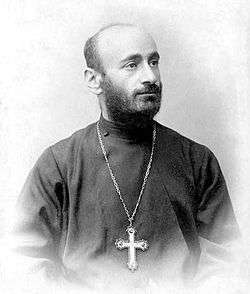
.png)
.png)
